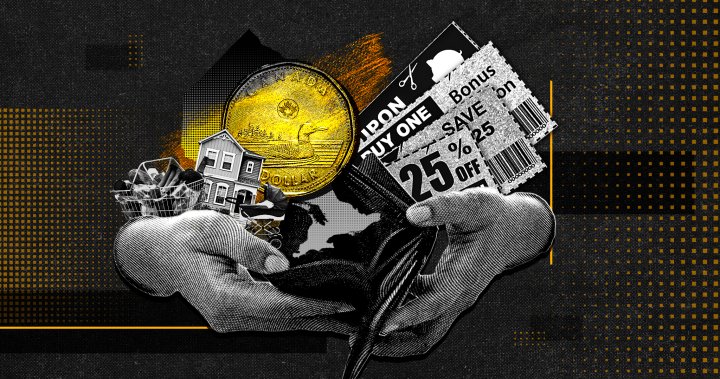This is the latest instalment of a Global News series called ‘On the Brink,’ which profiles people who are struggling with the rising cost of living. In this story, we meet a woman who has used couponing to help her family save money.
As economic uncertainty fuels volatile grocery prices, Canadians may be left feeling like their dollar is falling short.
Canada trades billions worth of grocery items with the U.S., including $72.6 billion in agriculture and agri-food products, according to government data.
With the countries stuck in a trade war, Canadians’ ability to access food and groceries may change for the worse, said Matt Poirier, vice-president of federal government relations for the Retail Council of Canada.
Now, more families will be trying to find ways to save and budget.
Meet Kathleen Cassidy, the creator behind Living on a Loonie – an Instagram account focused on helping people find ways to get deals and savings.
The couponer from Toronto said that amid the rising cost of food and groceries, people’s mindsets regarding couponing and saving money have shifted.
“People are … looking to spend a little bit more time and effort in things such as couponing, when before the taboo (was), ‘Oh, it takes a lot of time, it’s not worth it,’” Cassidy said.
In 2020, a year and a half after first starting the account while in university, Cassidy saw Living on a Loonie begin to take off when the impacts of COVID-19 began settling in.
Five years later, she now has more than 217,000 followers and has noticed interest in her work ebb and flow through different waves of inflation – including today’s trade war.
With tariffs expected to impact prices across multiple sectors, Cassidy has some ways to help people save.
“Start small. I always like to say look at one way that you can save, master that, do it very good, and then kind of move on to other avenues,” she said.
Cassidy added that one of the barriers to people saving money is brand loyalty and not shopping around.
She says coupons may be for different brands you have not tried or new items entering the market.
“It’s really just about being willing to try out those new products to get a good deal and really knowing the sales cycles in order to save the most money,” she said.
Cassidy also recommends people start budgeting and tracking their expenses.
“I know it takes a little bit of time, but even just spending 15 to 20 minutes a day going through everything on an Excel spreadsheet, that’s all I did,” she said.
“You can really get a sense of seeing where your money is going and how you can make small adjustments to cover those additional costs, especially as we see everyday essentials rise.”
She recommends that those just starting out begin with the basics, like planning out meals for the week, planning what to shop for, and looking through flyers.
“A lot of the time, food waste is a huge problem, and people don’t necessarily think about it this way, but when produce is going bad in your fridge, you’re throwing out your hard-earned dollars,” Cassidy said.
Thanks to couponing, Cassidy said she has been able to give back to her community while also helping her family.
“It has really helped my family and me financially because I am able to support with everyday items and get great deals on food,” she said.
“That really helps our bottom line so we can save our dollars to either do something that we love and enjoy, or in times such as this, to really save those dollars and put them where we need to.”
The fourth story in Global News’ relaunched On the Brink series is set to publish next Saturday.
— with files from Global News’ Saba Aziz
If you have a story about the cost of living you would like to tell please email us bellow.
On the Brink: How one Canadian uses couponing to fight inflation


